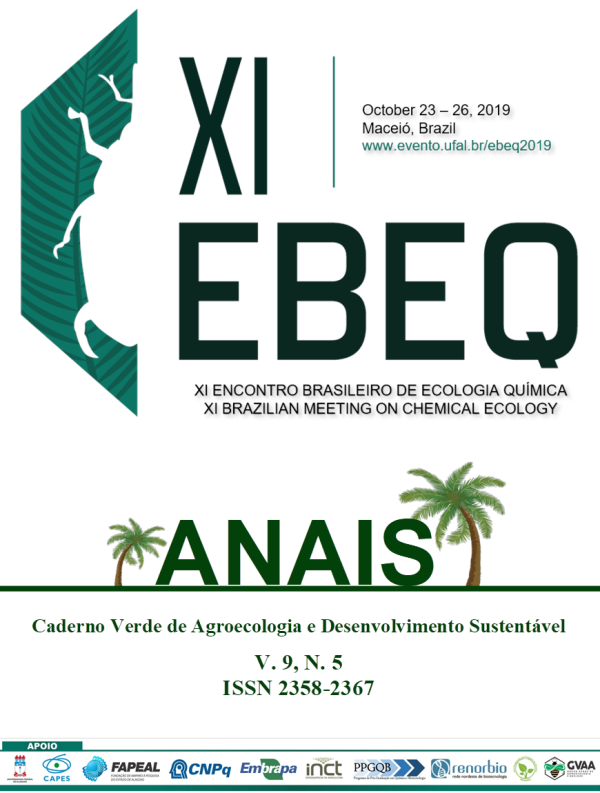BIOLOGICAL PRODUCTION OF MOTH PHEROMONES IN CELL AND PLANT FACTORIES
Palavras-chave:
METABOLIC ENGINEERING, (Z)-11-HEXADECENOL, Yarrowia lipolytica, Camelina sativa, Plutella xylostella.Resumo
The need for insect pheromones for pest control is increasing. Although synthetic insect pheromones can be produced in large volumes and used for mating disruption of insect pests to protect crops, the high cost of organic synthesis provides an obstacle for increasing the number of target insects and applications. Microbial cell factories as well as plants have been suggested as platforms for biological production of these high-value fine chemicals. Many moth sex pheromones are blends of modified fatty acids in the form of aldehydes, alcohols and acetates. By expressing the necessary and sufficient biosynthetic genes of insect and plant origin, we have made yeast and plants produce unsaturated fatty alcohols and acetates that are common moth pheromone compounds, as well as their fatty acid precursors. As a proof of concept, we co-expressed a ∆11 desaturase and a FAR in the Brewer’ s yeast Saccharomyces cerevisiae and produced (Z)-11-hexadecenol. In the OLEFINE project (OLEaginous yeast platforms for FINE chemicals, http://olefine.eu/) we develop novel technology for inexpensive biological production of pheromones from Yarrowia lipolytica in bioreactors. Another option is a plant factory, using genetically modified plants for production of pheromones. Using Nicotiana benthamiana as a platform, we produced 14C and 16C moth sex pheromone components by transient expression of up to four genes coding for consecutive biosynthetic steps. In the project Oil Crops for the Future we have produced genetically modified stable lines of the oil seed plant Camelina sativa that produce as much as 30% of selected pheromone fatty acid precursors. The isolated target precursors were reduced to fatty alcohols that were either used directly, oxidized to the corresponding aldehyde or acetylated. To validate the biological activity of the seed oil-derived compounds, we formulated sex pheromone baits for the diamondback moth, Plutella xylostella. Field trapping experiments revealed that the Camelina-derived pheromone is as attractive as conventionally produced pheromone.Downloads
Publicado
Como Citar
Edição
Seção
Licença
Termo de cessão de direitos autorias
Esta é uma revista de acesso livre, em que, utiliza o termo de cessão seguindo a lei nº 9.610/1998, que altera, atualiza e consolida a legislação sobre direitos autorais no Brasil.
O(s) autor(es) doravante designado(s) CEDENTE, por meio desta, publica a OBRA no Caderno Verde de Agroecologia e Desenvolvimento Sustentável, representada pelo Grupo Verde de Agroecologia e Abelhas (GVAA), estabelecida na Rua Vicente Alves da Silva, 101, Bairro Petrópolis, Cidade de Pombal, Paraíba, Brasil. Caixa Postal 54 CEP 58840-000 doravante designada CESSIONÁRIA, nas condições descritas a seguir:
O CEDENTE declara que é (são) autor(es) e titular(es) da propriedade dos direitos autorais da OBRA submetida.
O CEDENTE declara que a OBRA não infringe direitos autorais e/ou outros direitos de propriedade de terceiros, que a divulgação de imagens (caso as mesmas existam) foi autorizada e que assume integral responsabilidade moral e/ou patrimonial, pelo seu conteúdo, perante terceiros.
O CEDENTE mantêm os direitos autorais e concedem à revista o direito de divulgação da OBRA, com o trabalho simultaneamente licenciado sob a Licença Creative Commons do tipo atribuição CC-BY.
O CEDENTE têm autorização para distribuição não-exclusiva da versão do trabalho publicada nesta revista.
O CEDENTE têm permissão e são estimulados a publicar e distribuir seu trabalho online (ex.: em repositórios institucionais ou na sua página pessoal) a qualquer ponto antes ou durante o processo editorial, já que isso pode gerar alterações produtivas, bem como aumentar o impacto e a citação do trabalho publicado.










